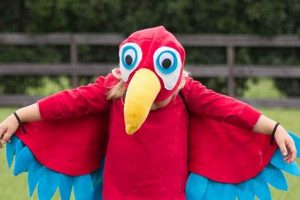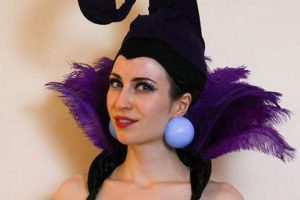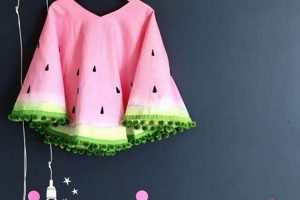Creating celebratory attire for Da de los Muertos involves crafting personalized outfits and accessories associated with this Mexican holiday. These creations often incorporate traditional elements like calaveras (skulls), vibrant colors, and floral designs. Examples include painting one’s face to resemble a sugar skull, assembling a colorful dress adorned with flowers, or constructing a headpiece with symbolic decorations.
Engaging in the creation of these unique ensembles offers several advantages. It allows for personal expression and creativity in honoring deceased loved ones. Furthermore, it can be a cost-effective alternative to purchasing pre-made costumes, enabling resourcefulness and ingenuity. Historically, these handcrafted representations serve as a tangible connection to cultural traditions and ancestral remembrance, strengthening familial bonds.
The following discussion will delve into specific techniques for face painting, dress design, and headpiece construction, providing practical guidance for individuals seeking to craft their own unique expressions for this important cultural observance.
Tips for Crafting Day of the Dead Attire
The following recommendations offer practical advice for individuals undertaking the creation of personalized Day of the Dead (Da de Muertos) costumes. Adhering to these suggestions will enhance the quality, authenticity, and durability of handcrafted attire.
Tip 1: Prioritize face paint quality. Opt for non-toxic, hypoallergenic face paints to minimize potential skin irritation during extended wear. Test a small area of skin before full application.
Tip 2: Incorporate traditional floral elements. Marigolds (cempaschil) are the quintessential flower of Da de Muertos. Integrate real or artificial marigolds into headpieces and attire for authentic symbolism.
Tip 3: Utilize durable construction techniques for headpieces. Employ sturdy wire frames and strong adhesives to ensure the stability and longevity of elaborate floral headpieces. Consider weight distribution for comfortable wear.
Tip 4: Layer clothing for visual depth. Combine various textures and fabrics to create a visually rich and impactful appearance. Consider incorporating lace, velvet, and embroidery.
Tip 5: Pay attention to detail in calavera (skull) makeup. Research traditional sugar skull designs and practice precise application techniques for achieving a realistic and evocative portrayal.
Tip 6: Secure costume elements effectively. Use strong pins, durable stitching, or reliable adhesives to firmly attach embellishments to clothing, preventing accidental detachment during events.
Tip 7: Consider weather conditions when selecting materials. If participating in outdoor festivities, choose breathable fabrics and waterproof makeup to ensure comfort and maintain appearance throughout the day.
Tip 8: Document the creation process. Taking photographs or videos of each stage provides a valuable record of the design and construction, allowing for future replication or adaptation.
By implementing these guidelines, creators can develop aesthetically pleasing, culturally respectful, and enduring representations of the Day of the Dead.
The ensuing sections will explore specific project ideas and offer in-depth tutorials for advanced costume construction techniques.
1. Calavera Face Painting
Calavera face painting is a cornerstone of Day of the Dead costume creation. Its execution represents a critical element in embodying the spirit of the celebration, transforming individuals into symbolic representations of departed souls. The artistry involved demands attention to detail and a comprehensive understanding of traditional motifs.
- Symbolic Representation
Calavera face painting directly translates to skull imagery, representing deceased ancestors. This imagery moves beyond simple death symbolism; it celebrates the lives and memories of those who have passed. Elaborate designs often incorporate flowers, spiderwebs, and other symbols representing specific aspects of life and death. Within the context of Da de Muertos attire, it serves as the primary visual indicator of participation in the celebration.
- Color Palette
The color choices within Calavera face painting are not arbitrary. White serves as the base, representing purity and the skeletal structure. Black outlines define features and create contrast. Vibrant colors like red, yellow, orange, and purple are used to adorn the skull, signifying joy, life, and remembrance. These colors contribute to the overall aesthetic impact of the costume and convey specific emotions and messages associated with the holiday. The careful selection and application of colors enhance the visual narrative of the Day of the Dead attire.
- Design Complexity
The complexity of Calavera face painting designs varies considerably, ranging from simple skull outlines to intricate depictions incorporating floral patterns, geometric shapes, and personalized details. Advanced techniques may involve shading, highlighting, and blending to create a three-dimensional effect. This allows individuals to express their personal artistic abilities and pay unique tribute to their loved ones. The level of detail incorporated into the face paint directly impacts the overall impact and authenticity of the costume.
- Material Selection
The quality and type of face paint used significantly impact the final result and the wearer’s comfort. Non-toxic, hypoallergenic face paints are essential to prevent skin irritation. The selection of brushes, sponges, and other application tools is equally crucial for achieving precise lines and smooth blending. The durability and longevity of the face paint should also be considered, particularly for extended periods of wear. Proper material selection ensures a comfortable and visually appealing Calavera face painting experience.
The various aspects of Calavera face painting converge to define the aesthetic and symbolic core of Day of the Dead attire. The integration of symbolic representation, careful color palette selection, design complexity, and appropriate materials directly influence the efficacy and impact of the costume as a tribute to the deceased and a celebration of life.
2. Floral Headpiece Design
Floral headpiece design constitutes an integral component of Day of the Dead attire creation. The construction and adornment of these headpieces represent more than mere aesthetic embellishment; they are symbolic representations deeply embedded within the cultural traditions of the celebration. The visual impact of a well-crafted headpiece significantly enhances the overall effectiveness of the attir
e, solidifying its connection to the holiday’s core themes of remembrance and celebration of life. Real-life examples, observed in parades and home altars, demonstrate the prominence and variety of designs, ranging from simple circlets to elaborate structures adorned with hundreds of flowers. This understanding provides a tangible objective when creating Day of the Dead attire.
The significance of these headpieces extends beyond visual appeal. They function as carriers of symbolism, with specific flowers possessing particular meanings. Marigolds, for example, are quintessential elements, their vibrant color and scent believed to attract the spirits of the deceased. Roses, lilies, and other flowers may also be incorporated, each contributing to the overall narrative conveyed by the costume. Practical application of this knowledge involves careful selection of flower types, strategic arrangement of colors, and secure attachment to a stable framework to ensure comfort and durability. Neglecting this aspect can diminish the impact of the attire and deviate from authentic representation.
In conclusion, effective floral headpiece design represents a crucial skill for achieving authentic Day of the Dead attire. The challenge lies in balancing artistic expression with cultural accuracy, ensuring the headpiece contributes meaningfully to the overall representation of remembrance and celebration. Failing to prioritize craftsmanship and understanding of the underlying symbolism risks undermining the intended message, separating the costume from its deeper cultural context. The link to the broader theme of honoring the deceased through carefully constructed attire remains paramount.
3. Traditional Dress Selection
Traditional dress selection represents a foundational element within the realm of creating Day of the Dead attire. The choice of garment significantly influences the overall authenticity and cultural resonance of the costume. Failure to consider traditional styles can result in a superficial representation, lacking the depth and symbolism inherent in the holiday’s customs. Historical examples reveal regional variations in dress, impacting contemporary DIY endeavors. For instance, the “China Poblana” dress, originating from Puebla, Mexico, embodies specific design elements that communicate cultural identity. Replicating or drawing inspiration from such styles demands an understanding of their origins and significance. Selecting appropriate dress types directly affects the costume’s ability to convey respect and honor for deceased ancestors, a central tenet of the Day of the Dead celebration.
Practical application involves researching regional variations in traditional Mexican clothing. Consideration should be given to fabric types, embellishments, and silhouettes. For example, dresses from Oaxaca often feature intricate embroidery depicting local flora and fauna. Emulating these techniques or incorporating similar motifs into a created garment enhances its cultural authenticity. Furthermore, the color palette plays a critical role. While vibrant colors are generally associated with the holiday, specific regions may favor particular hues. Integrating elements of traditional design requires careful attention to detail, ensuring the costume aligns with established cultural norms. Dismissing these considerations can result in a generic or culturally insensitive portrayal.
In summary, traditional dress selection constitutes a critical component of Day of the Dead attire. Recognizing the cause-and-effect relationship between garment choice and cultural representation is essential. The challenges lie in balancing personal creativity with respect for established traditions. The ultimate goal remains the creation of a costume that authentically honors the deceased and celebrates the continuity of life. Understanding this connection strengthens the overall message and reinforces the cultural significance of the holiday.
4. Skeletal Applique Creation
Skeletal applique creation represents a significant method for enhancing Day of the Dead attire. The process involves designing and affixing skeletal representations onto garments, transforming conventional clothing into symbolic representations of the deceased. The absence of such embellishments often results in costumes lacking the thematic depth and visual impact associated with the celebration. Real-world observations of Dia de los Muertos celebrations consistently demonstrate the prevalence of skeletal imagery, suggesting its critical role in conveying the holiday’s message. Therefore, mastering the techniques of skeletal applique creation is crucial for individuals seeking to craft authentic Day of the Dead costumes.
Practical application of this method requires consideration of several factors. Material selection plays a key role, with felt, fabric scraps, and even repurposed materials serving as potential mediums. Design choices range from simple bone outlines to elaborate full-skeleton depictions. Attachment methods vary depending on the base garment and applique material, including sewing, gluing, and ironing. Furthermore, incorporating traditional colors and patterns, such as floral motifs or geometric designs, enhances the cultural relevance of the applique. Skillful execution of these elements elevates the costume from a generic representation to a culturally informed homage.
In conclusion, skeletal applique creation constitutes an essential element in crafting compelling Day of the Dead attire. The challenge lies in effectively integrating skeletal imagery into the costume while respecting cultural sensitivities and traditions. Ultimately, the goal is to create a visually striking and meaningful representation that honors the deceased and contributes to the overall spirit of the celebration. Without effective application of this technique, the costume lacks the critical symbolism inherent in this holiday’s representation.
5. Symbolic Accessory Integration
Symbolic accessory integration holds a critical position in the realm of crafting Day of the Dead attire. These additions serve as potent visual cues, imbuing the costume with layers of meaning and cultural significance beyond mere aesthetic appeal. The strategic selection and incorporation of specific accessories elevate the attire from a simple outfit to a powerful representation of remembrance and celebration, aligning with the core tenets of the holiday.
- Marigold Representation
Marigolds, also known as cempaschil, represent the souls of the departed and are a quintessential accessory. Incorporating marigold garlands, headbands, or individual blooms directly connects the costume to the spiritual aspect of the holiday, guiding spirits back to the earthly realm. Examples include weaving marigolds into hair, attaching them to clothing, or creating elaborate floral necklaces. The absence of marigolds diminishes the costumes ability to convey this crucial aspect of Dia de los Muertos.
- Candle Representations
Miniature candle representations, often crafted from felt or lightweight materials, symbolize light and guidance for the returning spirits. Affixin
g these candle representations to clothing or carrying them as props reinforces the theme of illumination and direction. Examples include creating felt candle brooches, attaching small battery-operated lights to a headband, or carrying a miniature altar adorned with candles. These additions provide a visual and symbolic representation of the candles placed on traditional ofrendas. - Sugar Skull Imagery
Sugar skulls, or calaveras de azcar, symbolize the sweetness of life and remembrance. Miniature sugar skull replicas, often made from polymer clay or painted wood, can be incorporated into the costume as accessories. Examples include creating sugar skull earrings, necklaces, or attaching them to hats or belts. These additions serve as a tangible representation of the iconic sugar skull imagery associated with the Day of the Dead.
- Papel Picado Accents
Papel picado, or perforated paper banners, symbolize the fragility of life and the connection between the living and the dead. Miniature papel picado banners, either handmade or commercially produced, can be integrated into the costume as decorative elements. Examples include attaching small banners to hats, capes, or skirts. These additions provide a textural and visual element that reflects the celebratory atmosphere of the holiday and its focus on honoring deceased loved ones.
These symbolic accessories collectively enhance the meaning and impact of Day of the Dead attire. Their strategic integration ensures a more culturally resonant and visually compelling representation, effectively communicating the core themes of remembrance, celebration, and the enduring connection between the living and the deceased.
6. Material Sourcing Optimization
Material Sourcing Optimization, within the context of Day of the Dead costume creation, refers to the strategic procurement of resources necessary for crafting attire. It encompasses a range of considerations, from cost-effectiveness to the ethical implications of material choices, significantly impacting the accessibility and sustainability of DIY projects.
- Cost Management
The primary facet of material sourcing optimization involves minimizing expenses. Utilizing recycled materials, repurposing existing clothing, and comparing prices from various suppliers contribute to cost-effective costume creation. Real-life examples include sourcing fabric remnants from local textile shops or transforming old dresses into Day of the Dead-themed garments. Effective cost management expands access to costume creation, enabling participation for individuals with limited financial resources.
- Local Resource Utilization
Optimizing material sourcing entails prioritizing local resources. Supporting local businesses, sourcing fabrics from community cooperatives, and utilizing materials readily available within the immediate environment reduces transportation costs and supports local economies. An example includes sourcing marigolds, essential for Day of the Dead decorations, from local flower growers. Local resource utilization fosters community engagement and reduces the environmental impact associated with long-distance transportation.
- Sustainable Material Choices
Material sourcing optimization necessitates considering the environmental impact of chosen materials. Opting for sustainable fabrics, such as organic cotton or recycled polyester, minimizes the ecological footprint of costume creation. Furthermore, utilizing natural dyes and avoiding materials with harmful chemical treatments contributes to environmental responsibility. A practical example is using plant-based dyes extracted from local flora to color fabrics for the costume. Sustainable material choices align costume creation with environmentally conscious practices.
- Accessibility and Inclusivity
Optimized material sourcing considers the accessibility of materials for individuals with diverse needs. Prioritizing materials that are easy to manipulate, readily available in various sizes and textures, and accommodating to individuals with sensory sensitivities promotes inclusivity in costume creation. Examples include utilizing fabrics that are easily dyed and decorated by people with reduced mobility, therefore promoting a more inclusive costume creation process.
The interconnectedness of these facets highlights the multifaceted nature of material sourcing optimization in the creation of Day of the Dead attire. Integrating cost management, local resource utilization, sustainable material choices, and accessibility creates an empowering process that enriches both the individual experience and the broader community participation.
7. Authenticity in Representation
Authenticity in representation serves as a critical determinant of value in the creation of Day of the Dead attire. The act of crafting a costume for this celebration necessitates a mindful approach, ensuring that the resulting creation accurately and respectfully reflects the cultural traditions and symbolic meanings associated with the holiday. An absence of authenticity can diminish the intended impact of the costume, potentially misrepresenting or trivializing the profound significance of Day of the Dead. The rise in accessible creation has meant that the quality of cultural representation and celebration has varied greatly and in some cases, has been seen as culturally insensitive.
A practical application of this principle involves thorough research into the specific symbols, colors, and attire associated with different regions and communities within Mexico. For instance, incorporating specific embroidery patterns characteristic of Oaxaca or utilizing traditional sugar skull designs prevalent in central Mexico demonstrates a commitment to accurate representation. Conversely, blending elements from unrelated cultural traditions or adopting superficial interpretations of Day of the Dead imagery diminishes the costume’s authenticity. The impact of intentionality and study prior to DIY projects results in much more authentic results.
In summary, authenticity in representation constitutes a fundamental aspect of Day of the Dead costume design. The challenge lies in balancing personal creativity with respect for cultural integrity. A commitment to accurate and respectful portrayal elevates the costume from a mere superficial adornment to a meaningful expression of remembrance and cultural appreciation, contributing positively to the celebration’s significance. The value added to DIY projects when authenticity is the guide is great, and contributes to a respectful and authentic celebration.
Frequently Asked Questions
The following section addresses common inquiries regarding the creation of Day of the Dead attire, offering clarification and guidance on various aspects of the process.
Question 1: What constitutes cultural appropriation in Day of the Dead attire?
Cultural appropriation arises when elements of Day of the Dead traditions are adopted without understanding or respecting their cultural significance. This includes using costumes as mere fashion statements without acknowledging their symbolic connection to honoring deceased ancestors. The trivialization of cultural elements is a key indicator of appropriatio
n.
Question 2: How can one ensure respectful representation in Day of the Dead costume design?
Respectful representation involves thorough research into the historical and cultural context of Day of the Dead traditions. This includes understanding the symbolism of specific colors, flowers, and imagery associated with the holiday. Engaging with and supporting Mexican artisans and communities also contributes to respectful representation.
Question 3: What are the essential elements of a traditional Day of the Dead costume?
Essential elements typically include calavera (skull) face paint, floral headpieces, traditional Mexican clothing, and symbolic accessories such as marigolds and miniature ofrendas (altars). These elements serve as visual representations of remembrance and celebration, honoring the deceased and celebrating the continuity of life.
Question 4: What materials are most appropriate for crafting Day of the Dead attire?
Appropriate materials often include natural fabrics like cotton and linen, recycled materials, and locally sourced elements. Prioritizing sustainable and ethically sourced materials aligns with the spirit of remembrance and respect for the environment.
Question 5: How can one balance personal creativity with adherence to cultural traditions in Day of the Dead costume design?
Balancing creativity with tradition involves grounding personal interpretations in a solid understanding of Day of the Dead cultural elements. Experimentation with color palettes and design variations is acceptable, provided it respects the underlying symbolism and significance of the holiday.
Question 6: Where can one find reliable resources for learning about Day of the Dead traditions?
Reliable resources include academic texts on Mexican culture, documentaries featuring Day of the Dead celebrations, and collaborations with Mexican cultural organizations. Seeking guidance from individuals within Mexican communities ensures an accurate and respectful understanding of the holiday.
Key takeaways from this FAQ section emphasize the importance of cultural sensitivity, historical awareness, and ethical material sourcing in creating Day of the Dead attire.
The subsequent section will explore advanced techniques for crafting intricate Day of the Dead costumes.
Conclusion
The preceding exploration of “day of the dead costumes diy” has illuminated the multifaceted nature of this endeavor. It has emphasized the essential role of cultural sensitivity, accurate representation, and ethical material sourcing in the creation of meaningful attire. The discussion has encompassed techniques for face painting, headpiece design, dress selection, applique creation, accessory integration, and resource optimization.
As individuals embark on creating attire for Da de Muertos, a sustained commitment to understanding and respecting the cultural significance of the holiday remains paramount. The value of this endeavor lies not only in the aesthetic creation but also in the respectful homage paid to the traditions and the memories of those who have passed. Further education, community engagement, and mindful execution are crucial to honoring the integrity of this important cultural observance.







